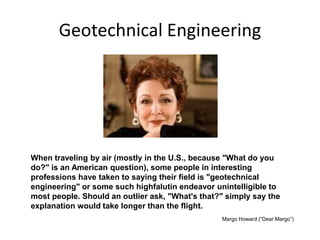Geotheta Things To Know Before You Get This
Geotheta Things To Know Before You Get This
Blog Article
Fascination About Geotheta
Table of ContentsAll about GeothetaThe Definitive Guide for GeothetaGeotheta Can Be Fun For AnyoneGeotheta Fundamentals ExplainedThe Best Strategy To Use For Geotheta

They carry out website examinations, accumulate examples, carry out laboratory tests, and assess information to review the viability of the ground for construction jobs - Tailings Engineer. Based upon their searchings for, geotechnical designers offer suggestions for foundation style, slope security, keeping structures, and reduction of geotechnical hazards. They team up with other specialists, such as engineers, architectural designers, and building and construction teams, to ensure that geotechnical factors to consider are integrated into the general job style and application
By evaluating the behavior and properties of dirt and rock, they can determine potential geotechnical threats such as landslides, soil settlement, or incline instability. Their experience assists prevent failures or accidents that could threaten lives and building. Right here are some comprehensive tasks and obligations of a geotechnical engineer: Site Investigation: Geotechnical engineers conduct site examinations to gather information on subsurface conditions.
They analyze the information to comprehend the residential or commercial properties and actions of the dirt and rock, including their stamina, permeability, compaction attributes, and groundwater problems. Geotechnical Analysis and Design: Geotechnical designers analyze the information accumulated throughout site investigations to examine the stability and suitability of the website for building and construction tasks. They do geotechnical estimations and modeling to evaluate elements such as bearing capacity, settlement, slope stability, side earth pressures, and groundwater circulation.
Not known Details About Geotheta
Foundation Layout: Geotechnical engineers play an important role in developing foundations that can safely support the intended framework. They analyze the dirt conditions and tons needs to identify the proper foundation kind, such as shallow foundations (e.g., grounds), deep foundations (e.g (https://www.avitop.com/cs/members/geotheta.aspx)., stacks), or specialized techniques like soil enhancement. They consider variables such as settlement limits, birthing ability, and soil-structure communication to establish ideal foundation styles
They assess building strategies, screen website activities, and conduct area assessments to confirm that the layout referrals are adhered to. If unanticipated geotechnical concerns develop, they examine the situation and offer suggestions for removal or adjustments to the design. Threat Assessment and Mitigation: Geotechnical designers analyze geotechnical dangers and dangers related to the job site, such as landslides, liquefaction, or dirt erosion.

Collaboration and Interaction: Geotechnical designers function very closely with other experts included in a job, such as architects, structural engineers, and construction groups. Efficient communication and collaboration are vital to integrate geotechnical factors to consider into the total job design and construction procedure. Geotechnical designers offer technical experience, solution queries, and ensure that geotechnical demands are fulfilled.
The Of Geotheta
Below are some sorts of geotechnical designers: Structure Engineer: Foundation engineers specialize in developing and assessing foundations for structures. They evaluate the dirt conditions, load needs, and website features to figure out one of the most appropriate structure kind and layout, such as superficial structures, deep foundations, or specialized techniques like heap foundations.
They evaluate the factors affecting incline stability, such as dirt residential or commercial properties, groundwater problems, and incline geometry, and create strategies to avoid incline failures and mitigate dangers. Earthquake Designer: Earthquake designers focus on examining and making structures to hold up against seismic pressures. They analyze the seismic danger of a site, evaluate soil liquefaction capacity, and establish seismic layout requirements to make sure the safety and security and resilience of frameworks throughout earthquakes.
They perform area screening, collect samples, and analyze the gathered information to identify the soil properties, geologic developments, and groundwater problems at a site. Geotechnical Instrumentation Engineer: Geotechnical instrumentation designers concentrate on surveillance and determining the habits of soil, rock, and frameworks. They mount and preserve instrumentation systems that keep track of aspects such as dirt settlement, groundwater degrees, slope activities, and architectural variations to analyze performance and supply very early warnings of possible problems.
Top Guidelines Of Geotheta
They perform tests such as triaxial examinations, loan consolidation examinations, straight shear examinations, and permeability tests to collect information for geotechnical evaluation and style. Geosynthetics Engineer: Geosynthetics engineers concentrate on the style and application of geosynthetic materials, such as geotextiles, geogrids, and geomembranes. They use these materials to boost soil security, strengthen inclines, offer water drainage services, and control disintegration.
They tend to be investigative individuals, which implies they're intellectual, introspective, and curious. They are curious, methodical, logical, logical, and logical. Some of them are also social, implying they're kind, charitable, cooperative, patient, caring, helpful, empathetic, tactful, and friendly - Tailings Engineer.
In the workplace atmosphere, geotechnical designers make use of specialized software devices to do computations, develop layouts, and examine information. They prepare records, testimonial task requirements, connect with clients and employee, visit the site and coordinate job tasks. The workplace setting provides a conducive atmosphere for research study, evaluation, and collaboration with various other experts associated with the project.
Geotheta Things To Know Before You Get This
They often visit task sites to perform site investigations, analyze geotechnical conditions, and collect information for evaluation. These sees entail taking a trip to different areas, often in remote or challenging surfaces. Geotechnical designers might carry out dirt sampling, conduct tests, and monitor building activities to guarantee that the geotechnical aspects of the task are being executed correctly.
Geotechnical designers also work in specialized geotechnical laboratories. Geotechnical lab designers function extensively in these environments, managing screening tools, running tools, and recording data.
Report this page